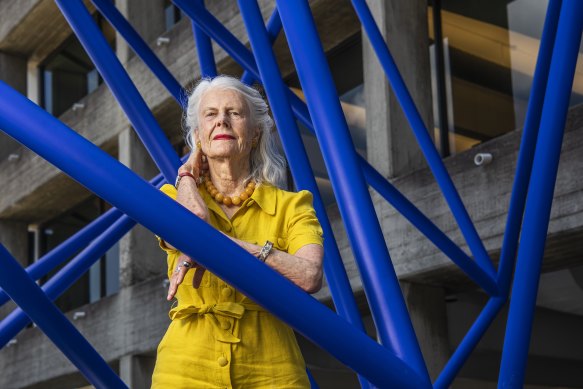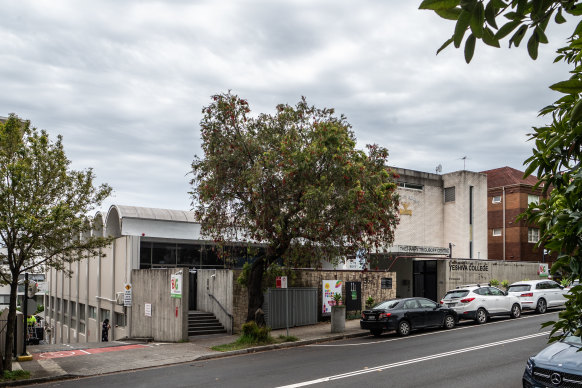This was published 1 year ago
Penelope Seidler joins fight to save Bondi synagogue from demolition
Penelope Seidler’s heart lit up when she entered the synagogue at the Yeshiva College in Bondi a couple of weeks ago.
It had been six decades since she first stepped inside the former Sydney Talmudical College at its opening in 1961.

The Bondi synagogue designed by Harry Seidler with its distinctive barrel vaulted roof.Credit: Max Dupain
Seidler said she was thrilled by the interior space of the building designed by her late husband Harry – one of Australia’s most renowned architects – and opened by her uncle, former foreign minister Dr Herbert Evatt.
“It’s a beautiful space,” she told The Sun-Herald. “It’s well worth preserving. The barrel vault structure is completely intact.”
Harry Seidler’s design was featured in The Sydney Morning Herald in February 1962, which noted that the semi-circular arch was considered symbolic and appropriate for Jewish architecture.
Penelope Seidler is worried the building is at risk of demolition after an application to rezone the site by Kanimbla, the development arm of billionaire property developer Harry Triguboff’s Meriton.

Penelope Seidler is happy to see the building used for a different purpose, just not destroyed.Credit: Steven Siewert
Seidler’s fears are shared by leading architects and members of the Jewish community, which has led to Waverley Council unanimously voting last week to apply an interim heritage order over the site.
The order, gazetted on Friday, said the attempt to rezone the site “is likely to lead to demolition of the Harry Seidler designed synagogue onsite”.
The order prevents demolition of the building for 12 months while the council conducts a detailed heritage assessment.
Waverley mayor Paula Masselos said the council wanted to retain scarce social and educational infrastructure.
“This historical religious and educational facility has served the Jewish community for more than 60 years and it is critical that this facility is not lost for this community,” she said.

The synagogue is part of Yeshiva College, also known as the Harry Triguboff Centre.Credit: Flavio Brancaleone
Despite later alterations such as a blast wall to protect the synagogue from attack, council papers said the building retained the core form and detail of Seidler’s design.
Seidler’s daughter, Polly, said the synagogue was the only religious building designed by her father.
The significant aspects of the building include the entry forecourt and barrel-vaulted roof that Polly said was the earliest design of its type and the only example left in NSW.
“The building should be heritage listed both at local and state levels – not demolished for the owner’s plans for residential use,” she said in a letter to the NSW Planning Department.
Waverley Council rejected the rezoning request last year, but the NSW Planning Department allowed the proposal to proceed to public exhibition following a recommendation by the Sydney Eastern City Planning Panel.
A Planning Department spokeswoman said the planning panel will reconsider the proposal before the department makes a final decision on whether the site should be rezoned to permit residential development.
The Bondi site is owned by an arm of Triguboff’s property company Meriton and contains Our Big Kitchen charity and Yeshiva College, which was shut down last year after accusations it used government funding to pay unaccredited teachers and put students’ safety at risk.
A Meriton spokesman said a planning panel had supported the rezoning.
“The council can have their opinion, but the panel will decide,” he said. “The council doesn’t like the approval.”
University of NSW Emeritus Professor James Weirick said the Seidler-designed building met several of the criteria for heritage listing and was historically significant for its role in the recovery of Jewish life and learning in Australia in the aftermath of the Holocaust.
DOCOMOMO, an international organisation that lobbies for the conservation of Modernist architecture, has also expressed concern for the future of the building if rezoned.
Australian Institute of Architects NSW president Adam Haddow said the significance of Seidler’s only completed religious building needed to be understood before a rezoning is considered.
Haddow said the future of the building “is incredibly open” if it was no longer used as a synagogue or educational facility.
“Heritage buildings do present more challenges when they are proposed to be converted into residential dwellings,” he said. “However they also present remarkable opportunities – we’ve all seen remarkable homes accommodated in old churches.”
Seidler said she saw no problem with the site being rezoned as residential and her husband’s architecture used for a difference purpose.
“This space is suitable for any public recreation,” she said. “It doesn’t have to be a synagogue. It could be a community hall.”